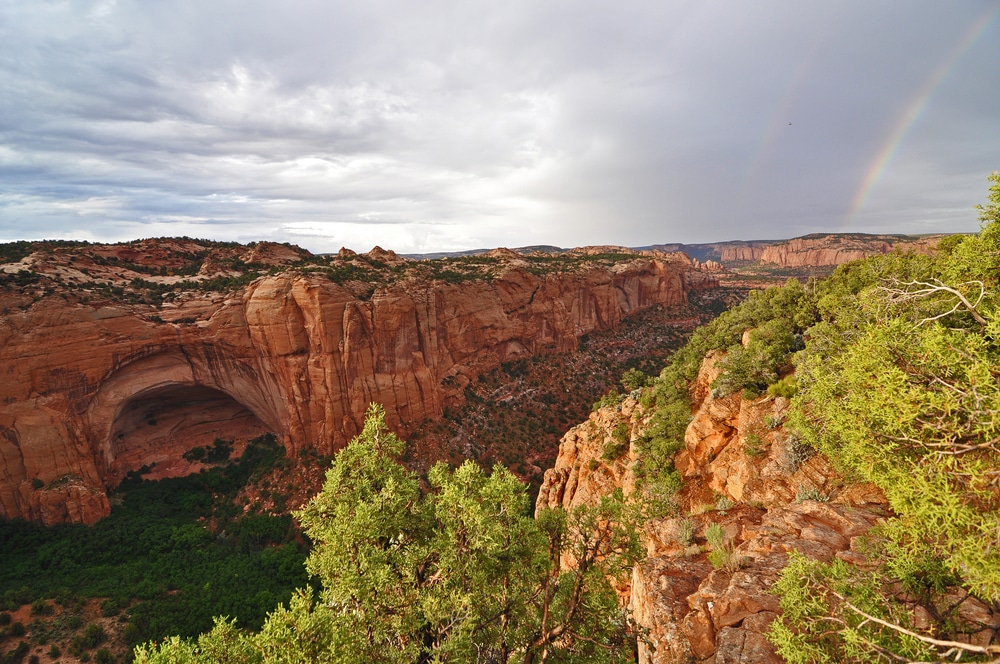Tucked away in the remote northeastern corner of Arizona, Navajo National Monument stands as a remarkable testament to the ingenuity and resilience of ancestral Puebloan peoples who once called this rugged landscape home. Established in 1909 to protect some of the most intact cliff dwellings in the American Southwest, this 360-acre monument preserves not only architectural marvels but also the cultural heritage and spiritual connections that have endured for centuries.
The monument’s centerpiece attractions—Betatakin, Keet Seel, and Inscription House—are among the best-preserved Ancestral Puebloan cliff dwellings in the United States, offering visitors a glimpse into a sophisticated civilization that thrived in this seemingly inhospitable environment between 1250 and 1300 CE. These ancient structures, nestled within the protective alcoves of towering sandstone canyons, tell a compelling story of human adaptation, community organization, and spiritual connection to the land.

Navajo National Monument occupies a unique position in Arizona’s network of public lands, sitting entirely within the boundaries of the Navajo Nation. This administrative arrangement creates a valuable partnership between the National Park Service and the Navajo people, many of whom consider these ancestral sites sacred. The monument thus represents not only a archaeological treasure but also a living cultural landscape where ancient history and contemporary Native American traditions intersect.
For visitors seeking to understand the rich tapestry of human history in the American Southwest, Navajo National Monument offers an unparalleled opportunity to experience well-preserved ancient architecture in its original setting, learn from both scientific research and indigenous knowledge, and gain appreciation for the deep cultural connections that continue to give meaning to this remarkable landscape.

Navajo National Monument is home to three well-preserved Ancestral Puebloan cliff dwellings, built between 1250 and 1300 CE:
These dwellings offer a glimpse into the lives of the Ancestral Puebloans and their skillful masonry and adaptation to the desert environment.

Start your visit at the Navajo National Monument Visitor Center to learn about the park’s history, culture, and natural environment. The Visitor Center features:

Ranger-led tours are the highlight of visiting Navajo National Monument, offering an up-close look at the cliff dwellings:
These tours operate seasonally (spring through fall), so check availability in advance.

The monument is located on the Navajo Nation, and the Navajo people have a deep connection to the land. Visitors can learn about Navajo traditions, art, and history through:

Navajo National Monument offers two free campgrounds with incredible views of the surrounding desert landscape:
Camping at the monument is a great way to experience the quiet beauty of the desert and enjoy stargazing at night.

The dramatic sandstone canyons, ancient cliff dwellings, and desert vegetation make Navajo National Monument a dream for photographers. Best times for photography are during sunrise and sunset, when the light enhances the red and orange hues of the sandstone cliffs. Don’t miss:
With its remote location and minimal light pollution, Navajo National Monument is an excellent spot for stargazing. On clear nights, you can see the Milky Way, constellations, and countless stars. Bring a telescope or just enjoy the view from the campgrounds or trails.

| Category | Details |
|---|---|
| Location | Northeastern Arizona, near Kayenta and the Navajo Nation |
| Established | March 20, 1909 |
| Managed By | National Park Service |
| Size | Approximately 360 acres (145 hectares) |
| Main Attractions | Betatakin, Keet Seel, and Inscription House cliff dwellings |
| Cultural Significance | Preserves ancient Puebloan cliff dwellings from the Ancestral Puebloan culture (built around 1250–1300 CE) |
| Archaeological Importance | The cliff dwellings are some of the best-preserved examples of ancient Puebloan structures. |
| Ecosystem | High desert with piñon pines, junipers, and sagebrush |
| Wildlife | Includes mule deer, coyotes, rabbits, lizards, and diverse bird species |
| Trails | – Sandal Trail: A short paved trail to an overlook of Betatakin- Keet Seel Trail: A challenging backcountry hike requiring a permit |
| Nearby Landmarks | Monument Valley, Canyon de Chelly National Monument, Lake Powell |
| Visitor Activities | Guided hikes, self-guided trails, ranger programs, and cultural exhibits |
| Climate | Hot summers, cold winters, with mild spring and fall temperatures |
| Accessibility | Visitor center and Sandal Trail are wheelchair accessible |
| Entrance Fee | No entrance fee |
| Camping | Free camping available at Sunset View and Canyon View campgrounds |
| Fun Fact | Betatakin, meaning “House Built on a Ledge” in Navajo, is a massive cliff dwelling with over 120 rooms! |
Navajo National Monument is situated in northeastern Arizona, approximately 140 miles northeast of Flagstaff and 20 miles southwest of Kayenta. The monument lies entirely within the Navajo Nation, one of the largest Native American reservations in the United States. This remote location contributes to the monument’s pristine condition but requires some planning for visitors.
The monument is accessible via State Highway 564, which connects to U.S. Highway 160. From Flagstaff, visitors can take US-89 north to US-160, then follow signs to the monument. From the east (Four Corners area), US-160 provides direct access. The approach from either direction offers spectacular views of the Colorado Plateau landscape, with its dramatic mesas, buttes, and sweeping vistas.
While the roads leading to the monument are paved and generally well-maintained, visitors should be aware that:
Upon arrival, visitors will find:
The visitor center, museum, and restrooms are wheelchair accessible. The Sandal Trail to the Betatakin overlook is paved for the first quarter-mile and accessible for most visitors, though the full one-mile round trip includes some moderate elevation change. Access to the actual cliff dwellings is more challenging:
Visitors with mobility concerns should contact the monument in advance to discuss options and current trail conditions.
Navajo National Monument protects three primary cliff dwelling sites—Betatakin, Keet Seel, and Inscription House—each representing remarkable achievements in prehistoric architecture and community planning. These structures were built and occupied primarily between 1250 and 1300 CE, during what archaeologists call the Pueblo III period, before being abandoned as their inhabitants migrated southward.
Meaning “ledge house” in Navajo, Betatakin contains approximately 135 rooms nestled within a soaring sandstone alcove that measures 452 feet high and 370 feet wide. This natural shelter protected the village from the elements, helping preserve its structures for over 700 years. Notable features include:
Visitors can view Betatakin from the Sandal Trail overlook or join ranger-guided hikes that provide access to the dwelling itself during the summer months. These guided experiences offer insights into construction techniques, daily life, and the environmental factors that both enabled this community to thrive and eventually contributed to its abandonment.
Often described as the most intact large cliff dwelling in the American Southwest, Keet Seel (meaning “broken pottery” in Navajo) contains 160 rooms and shows evidence of continuous construction over several decades. More remote than Betatakin, this site features:
Access to Keet Seel is strictly limited to preserve its fragile structures. Visitors must obtain permits in advance (available starting in early March for the summer season) and be prepared for a challenging hike that includes stream crossings and steep sections. The effort is rewarded with an intimate experience of one of the most remarkable archaeological sites in North America.
The third major site within the monument, Inscription House, contains approximately 74 rooms and received its English name from an inscription left by a passing traveler in 1661. Currently closed to protect its fragile structures from deterioration, this site nevertheless represents an important component of the monument’s archaeological record and ongoing preservation efforts.
These dwellings represent the culmination of Ancestral Puebloan building technology and social organization. Key aspects of their archaeological significance include:
Ongoing research at these sites continues to enhance our understanding of how these communities adapted to environmental challenges, organized their societies, and eventually made the decision to migrate away from their carefully constructed homes.
Navajo National Monument exists within a remarkable ecological setting that helps visitors understand how Ancestral Puebloan communities sustained themselves in this seemingly harsh environment. The monument’s natural resources provide valuable context for appreciating the human history preserved here.
The dramatic sandstone canyons that shelter the monument’s cliff dwellings are composed primarily of Navajo Sandstone, a formation created from ancient sand dunes approximately 190 million years ago. Key geological features include:
This geology not only created the natural shelters that made the cliff dwellings possible but also influenced everything from construction materials to agricultural practices of the ancestral peoples.
The monument encompasses several distinct plant communities that reflect its elevation range and microclimate variations:
Many of these plants had significant practical and cultural importance to ancient inhabitants, providing food, medicine, construction materials, and tools. The Aspen Forest Trail offers visitors an opportunity to explore some of these plant communities and learn about their traditional uses.
The monument’s varied habitats support diverse wildlife, though many species are elusive and most active during dawn and dusk hours. Notable species include:
Wildlife observation opportunities are best along the monument’s trails during quieter periods, particularly in early morning. The visitor center provides information on recent wildlife sightings and seasonal activity patterns.
Navajo National Monument experiences a high desert climate characterized by:
These climatic patterns helped shape the agricultural practices of ancient inhabitants, who carefully selected field locations to maximize limited moisture and protect crops from early and late frosts at this 7,300-foot elevation.
Navajo National Monument holds profound cultural significance that extends far beyond its archaeological value, representing a living connection between past and present for multiple Native American tribes. Understanding these cultural dimensions enriches the visitor experience and promotes respect for the sacred nature of these sites.
While the cliff dwellings were built by ancestral Puebloan peoples, several contemporary tribes maintain cultural connections to these sites:
Hopi: Many Hopi clans trace their migration histories through these dwelling sites, considering them ancestral homes along their people’s journey to their current mesas. Hopi oral traditions provide detailed knowledge about specific rooms, kivas, and the activities that once took place here.
Zuni: The Zuni people also recognize these sites as part of their ancestral territory and include them in traditional cultural knowledge.
Navajo (Diné): Though the Navajo arrived in the region after the cliff dwellings were abandoned, they have developed deep relationships with this landscape over centuries. Navajo oral traditions explain the abandoned dwellings as homes of “the Ancient Ones” and incorporate these places into their understanding of proper relationships between humans and the environment.
San Juan Southern Paiute: This tribe also maintains cultural connections to the monument area and contributes to interpretive programs.
The monument works closely with affiliated tribes to ensure that interpretation reflects indigenous perspectives and respects ongoing cultural practices:
Visitors should understand that for many Native Americans, these sites aren’t simply archaeological artifacts but places of continuing spiritual significance that connect present generations to their ancestors.
The monument’s interpretive programs strive to present multiple perspectives on the cliff dwellings and their inhabitants:
This multifaceted approach encourages visitors to appreciate both the scientific value of these sites and their enduring cultural significance to living communities.
While Navajo National Monument is primarily focused on cultural and historical preservation, it offers several recreational opportunities that allow visitors to experience the landscape that shaped ancestral Puebloan life.
The monument features several hiking options of varying difficulty:
Sandal Trail: A paved, 1-mile round trip path that leads to an overlook of Betatakin cliff dwelling. Suitable for most visitors and offering interpretive signs along the route.
Aspen Forest Trail: A 0.8-mile loop through a beautiful stand of aspen trees on the canyon rim, providing insights into the local ecology and forest habitat.
Betatakin Canyon Hike: A ranger-guided 5-mile round trip descent into the canyon to visit Betatakin dwelling up close. This strenuous hike involves 700 feet of elevation change and is offered only during summer months, weather permitting.
Keet Seel Trek: For experienced hikers, the 17-mile round trip journey to Keet Seel represents one of the Southwest’s premier archaeological experiences. Permits are required, with a strict limit of 20 visitors per day during the operating season (typically late May through early September).
All hikes offer stunning views of the canyon landscape and opportunities to observe plants, wildlife, and geological features that influenced ancestral Puebloan lifeways.
The monument offers exceptional photography opportunities for both landscape and architectural subjects:
Photographers should be aware of tribal sensitivities regarding certain sacred sites and check with monument staff about any restrictions before photographing.
The monument’s small campground provides an excellent base for exploring the area:
The campground’s 7,300-foot elevation offers cool, pleasant conditions during summer, though nights can be chilly even in warmer months. Winter camping is available but requires preparation for potentially freezing temperatures.
The monument’s remote location and minimal development create outstanding opportunities for night sky observation:
Visitors can enjoy these astronomical displays from the campground or designated viewing areas near the visitor center.
Throughout the year, but especially during summer months, the monument offers cultural programs that enhance the visitor experience:
These interpretive opportunities transform a visit from simple sightseeing to a deeper understanding of the monument’s significance.
Navajo National Monument operates year-round, though services vary seasonally:
While the monument can be visited any time of year, summer offers the most complete experience with full ranger programs and access to cliff dwellings. Spring and fall provide milder temperatures for hiking, while winter visits offer solitude and occasionally dramatic snow-dusted landscapes.
The monument’s remote location and environmental conditions require certain precautions:
Elevation: At 7,300 feet, visitors coming from lower elevations may experience altitude effects and should stay hydrated and pace activities accordingly.
Weather: Summer brings possibility of sudden thunderstorms with lightning danger; winter can bring snow and ice on trails. Check forecasts before hiking.
Sun Exposure: The high desert environment features intense UV exposure year-round. Sunscreen, hats, and adequate water are essential.
Hiking Preparation: Canyon hikes require proper footwear, sufficient water (at least 2 quarts per person for Betatakin, 1 gallon for Keet Seel), and awareness of personal limitations.
Emergency Services: The monument is far from major medical facilities. Cell phone coverage is limited or non-existent in many areas.
Cultural Sensitivity: Some areas may have specific behavioral protocols out of respect for their sacred nature. Always follow ranger guidance.
Visitors will have a more enjoyable experience if they come prepared with:
The monument’s remote location means limited services in the immediate vicinity:
Visitors planning a longer stay in the region may wish to combine their monument visit with other nearby attractions:
Navajo National Monument faces several conservation challenges while working to preserve its irreplaceable resources for future generations.
The National Park Service employs various strategies to protect the fragile cliff dwellings:
Controlled Access: Limiting visitation through guided tours and permit systems helps minimize impact on structures.
Monitoring Systems: Scientific instruments track environmental conditions that might affect site preservation, including temperature, humidity, and vibration.
Documentation: Detailed mapping, photography, and 3D scanning create comprehensive records of the structures’ current condition for comparison over time.
Stabilization Work: Minimal interventions maintain structural integrity while respecting the original construction techniques and materials.
Traditional Knowledge: Consultation with affiliated tribes incorporates indigenous perspectives into preservation approaches.
These efforts represent a careful balance between providing public access and protecting irreplaceable cultural resources.
Several factors pose ongoing challenges to the monument’s preservation mission:
Climate Change: Shifting precipitation patterns and temperature regimes may affect the natural shelters that have protected these structures for centuries.
Erosion: Occasional heavy rainfall events can trigger erosion that threatens both access routes and the dwellings themselves.
Invasive Species: Non-native plants can alter the ecological balance and potentially damage archaeological resources.
Visitation Impacts: Even with careful management, human presence inevitably causes gradual wear on fragile structures and trails.
Park management continually adapts strategies to address these evolving challenges while maintaining the visitor experience.
Visitors play a crucial role in preservation through responsible behavior:
Stay on Designated Trails: Wandering off established paths can damage fragile desert soils and potentially undocumented archaeological resources.
Practice “Leave No Trace”: Pack out all trash and minimize impact on campsites.
Respect Guidance: Follow ranger instructions regarding touching structures, photography limitations, or area closures.
Report Concerns: Alert staff to any observed damages, vandalism, or potential preservation issues.
Support Conservation: Consider joining partner organizations that support the monument’s preservation mission.
By treating the monument with respect, visitors become partners in ensuring these remarkable structures survive for future generations.
Navajo National Monument offers a rare opportunity to connect with one of North America’s most fascinating cultural chapters. Here, in these remarkably preserved dwellings nestled within towering sandstone alcoves, visitors can glimpse the ingenuity, adaptability, and spiritual connection to place that characterized ancestral Puebloan communities.
The monument’s significance extends beyond its archaeological value. These sites represent living heritage for multiple Native American tribes who maintain cultural and spiritual connections to the landscape. By presenting both scientific understanding and indigenous perspectives, the monument encourages visitors to appreciate the multiple ways of knowing and valuing this remarkable place.
For those willing to make the journey to this remote corner of Arizona, Navajo National Monument rewards with experiences unavailable in more developed parks: intimate encounters with nearly intact 700-year-old architecture, ranger-led explorations that bring ancient lifeways into focus, and the opportunity to contemplate human resilience in a challenging environment. The monument’s relative isolation preserves not only the physical structures but also a sense of discovery and connection that can be difficult to experience at more heavily visited sites.
As climate change and other pressures create new preservation challenges, the collaborative management approach between the National Park Service and affiliated tribes offers a model for how cultural resources can be protected while honoring their ongoing significance to living communities. Visitors who come with respect and curiosity become part of this stewardship tradition, helping ensure that these remarkable windows into ancient lifeways remain open for generations to come.
Whether your interest lies in archaeology, Native American cultures, desert ecology, or simply experiencing the profound sense of place that these ancient communities recognized centuries ago, Navajo National Monument offers an authentic and meaningful encounter with Arizona’s rich cultural landscape.
We use cookies to improve your experience on our site. By using our site, you consent to cookies.
Manage your cookie preferences below:
Essential cookies enable basic functions and are necessary for the proper function of the website.
Statistics cookies collect information anonymously. This information helps us understand how visitors use our website.
Marketing cookies are used to follow visitors to websites. The intention is to show ads that are relevant and engaging to the individual user.